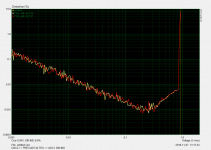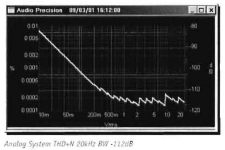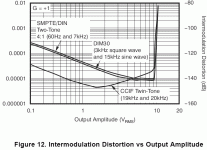So now we shall read a couple of ****-and-bull stories based on
ESS THD ‘Hump’ Investigation | Audio Science Review (ASR) Forum
saying that the AD797 is the reason of the ESS "THD/IMD hump".
I made a brief set measurement on the tested preamp#1, exchanging AD797 x AD744 opamps. Both are quite different topologies. THD and DIN IMD vs. level was tested. DAC with balanced output was used to better fit to the preamp input. Switching between AD797 and 744 makes no difference in this set of measurements, as the are determined by DAC/ADC parameters. No THD/IMD "hump" is present.
ESS THD ‘Hump’ Investigation | Audio Science Review (ASR) Forum
saying that the AD797 is the reason of the ESS "THD/IMD hump".
I made a brief set measurement on the tested preamp#1, exchanging AD797 x AD744 opamps. Both are quite different topologies. THD and DIN IMD vs. level was tested. DAC with balanced output was used to better fit to the preamp input. Switching between AD797 and 744 makes no difference in this set of measurements, as the are determined by DAC/ADC parameters. No THD/IMD "hump" is present.
Attachments
Pavel,
I just made a quick and sighted listening, before to read the results (that I had not read yet).
Clear differences, on my PC litle speakers and my mobile headphones (Koss Porta pro).
More obvious on my big system (horns) or the little KEF LS 50 Wireless.
Both files are OK, and the differences are obvious in my ears in the four situations.
Both files are a little 'thin" to my ears, especially the brass section that miss a little of 'body'. A lot on the Kef that are too thin by themselves. Near ok on my big system at high level.
Sadly, there is not enough drums to judge the micro dynamic.
As I have this record in my library, I can compare too with my own CFA preamp that I prefer, both more detailed and less aggressive. (This record of Harry Connick Jr. is not the best he made, on the recording point of view)
I definitely prefer the 1 of your 2 files. More dynamic, more separation: the second is a little too much 'smoothed' to my taste.
It is just feelings, of course. I made no ABX.
Remain for me the always unanswered question: how 3 preamps, both perfectly flat in *my* audio bandwidth (I'm an old man), with, I suppose, measured distortions well under what we suppose our threshold of audibility can present so obvious differences ?
Thanks for the effort, this kind of research is always instructive on the long run.
I just made a quick and sighted listening, before to read the results (that I had not read yet).
Clear differences, on my PC litle speakers and my mobile headphones (Koss Porta pro).
More obvious on my big system (horns) or the little KEF LS 50 Wireless.
Both files are OK, and the differences are obvious in my ears in the four situations.
Both files are a little 'thin" to my ears, especially the brass section that miss a little of 'body'. A lot on the Kef that are too thin by themselves. Near ok on my big system at high level.
Sadly, there is not enough drums to judge the micro dynamic.
As I have this record in my library, I can compare too with my own CFA preamp that I prefer, both more detailed and less aggressive. (This record of Harry Connick Jr. is not the best he made, on the recording point of view)
I definitely prefer the 1 of your 2 files. More dynamic, more separation: the second is a little too much 'smoothed' to my taste.
It is just feelings, of course. I made no ABX.
Remain for me the always unanswered question: how 3 preamps, both perfectly flat in *my* audio bandwidth (I'm an old man), with, I suppose, measured distortions well under what we suppose our threshold of audibility can present so obvious differences ?
Thanks for the effort, this kind of research is always instructive on the long run.
Last edited:
Yes, the worldstring 1 is way cleaner, better bass, I can’t tell if it’s too bright as my main system is boxed up; my shop system is a little ‘bright’ anyway.
Hey-up, the golden ear brigade have come out of the woodwork now all has been revealed 😉🙄
I passed 😛
That’s even on my shop system 😀
So now we shall read a couple of ****-and-bull stories based on
ESS THD ‘Hump’ Investigation | Audio Science Review (ASR) Forum
saying that the AD797 is the reason of the ESS "THD/IMD hump".
PMA,
Did you use the same input DC bias as is present on the opamps in cases where a hump is observed?
It's +1.65v on the I/V stage and +1.65v on the differential-summing/balanced-MFB-filter stage.
I was curious what it is that was not measured that contributed to the perceived difference which is in agreement with your long term experience. With THD of 0.003% and 0.005%, are you saying 0.002% difference is that obvious? That is at -90.4 dB, I thought differences at -80 dB is very difficult to tell already. What is your honest opinion on the matter?So now we shall read a couple of ****-and-bull stories based on...
Last edited:
I consider W2 to be materially superior to W1. It permits me to hear deeper into the music and its pacing of the music seems materially more natural.
To the extent it is relevant, am listening over a Windows computer through a Project Box S2 Digital DAC/Headphone Amplifier with Mitchell & Johnson GL-2 Electrostaz Headphones.
To the extent it is relevant, am listening over a Windows computer through a Project Box S2 Digital DAC/Headphone Amplifier with Mitchell & Johnson GL-2 Electrostaz Headphones.
Obvious. In my book, most of the measurements we use in audio are just good enough to reject bad designed parts or improve-them on the bench.I was curious what it is that was not measured that contributed to the perceived difference.
And, after this initial sorting was done, there is no part that are better than another in an absolute way. All our system assembly has to be kept in consideration, some parts compensating by their flaws the flaws of other parts.
And still remain some mystery in the way we perceive sound characters.
A perfect electronic audio system do not exists as-it. It is the way each one excite our personal speakers in our personal listening room that matters.
Sorry for the pure objectivists.
And no need neither for complicated blind ABX: Pleasure and make believe only matter, and we have all our own personal musical culture, that are not the same at all between individuals.
Last edited:
IMD of LME49990 showed similar jagged line on the datasheet itself, albeit at a much lower level.
That jagged line is auto range-switching of the test set. Nothing to do with the DUT.
Jan
Last edited:
I was curious what it is that was not measured that contributed to the perceived difference which is in agreement with your long term experience. With THD of 0.003% and 0.005%, are you saying 0.002% difference is that obvious? That is at -90.4 dB, I thought differences at -80 dB is very difficult to tell already. What is your honest opinion on the matter?
The rise time is the biggest difference that was measured.
Having access to the original would be useful. Should always follow these interesting adventures.
//
//
Thanks Jan, makes more sense now.That jagged line is auto range-switching of the test set. Nothing to do with the DUT.
Don't be so dismissive to unverified measurement. IMD of LME49990 showed similar jagged line on the datasheet itself, albeit at a much lower level.
You are clearly not aware of range switching in test equipment...
Yes, you see it very often. Actually it is a sort of indicator, saying that you are measuring close to the test set residual.
Here's an old AP testing itself ;-)
This reminds me of a book by I think Richard Dawkins about how ideas ('memes') can spread based on a single erroneous observation.
All of a sudden certain opamps and circuits have 'IMD humps' and after a while it is 'everybody knows that ... '.
Jan
Here's an old AP testing itself ;-)
This reminds me of a book by I think Richard Dawkins about how ideas ('memes') can spread based on a single erroneous observation.
All of a sudden certain opamps and circuits have 'IMD humps' and after a while it is 'everybody knows that ... '.
Jan
Attachments
Last edited:
The rise time is the biggest difference that was measured.
The rise time (or frequency range, call it as you like) and the noise level which is more than 10dB better for #1 preamp. This is a lot, both. #1 is almost 10x faster and 10dB less noisier. IMO and IME linear changes (FR, Tr) and reduced noise make much more difference than nonlinear distortion. #1 is more transparent, more accurate, with higher subjective dynamics and more impact. Less forgiving and less smoothing. This is my experience that such component is often not well accepted, because it is too revealing. Interestingly enough the base of these differences was possible to transfer even through the DAC-ADC path and display it as sound samples into public.
I think that Scott Wurcer has completely disproved the suspicion of AD797 responsibility to ESS "IMD hump" in this post:
John Curl's Blowtorch preamplifier part III
Indra1, the "Samuel" mentioned in Scott's post is Samuel Groner. His detailed work on opamp distortion that I linked few hours ago is a must read, in case someone is interested in a deeper view.
John Curl's Blowtorch preamplifier part III
Indra1, the "Samuel" mentioned in Scott's post is Samuel Groner. His detailed work on opamp distortion that I linked few hours ago is a must read, in case someone is interested in a deeper view.
I guess not every manufacturer use IMD tester that TI (Burr Brown) use. Kind of misleading to those not that familiar with that kind of signature though, even Pavel did not show suspicion of range switching artefacts.
This is Cabot measurement and distortion comparison. Nothing in common with the suggested "IMD hump", which is a bow like rise of non-linearity somewhere at mid levels, returning to low values again. Some parts just get progressively less linear at high/higher amplitudes for many reasons. Not necessarily for the reason of switching distortion. Do you think that the AP does not use opamps? Really, the suspicion of AD797 hump was funny and yes, I got irritated a bit. There are still not many parts, if any, to beat AD797 parameters in audio band. Hats off, Scott.
- Home
- General Interest
- Everything Else
- Can you hear a difference between 2 solid state preamps?



